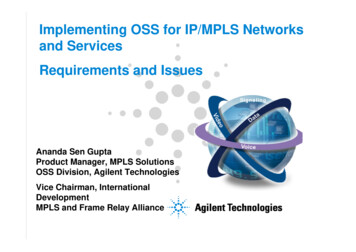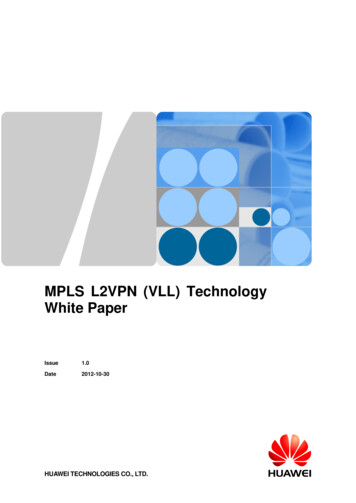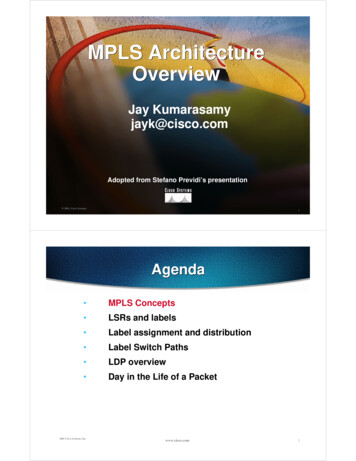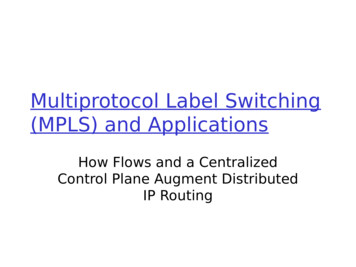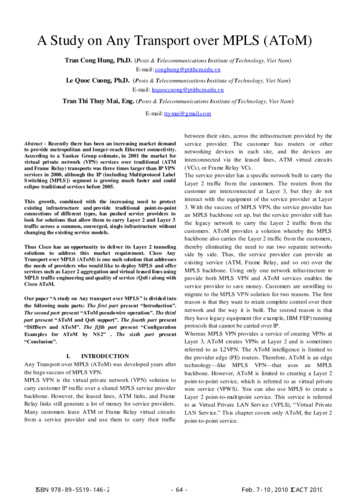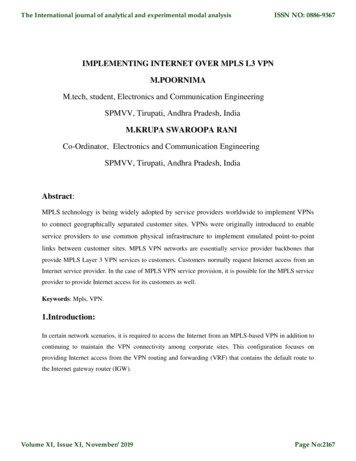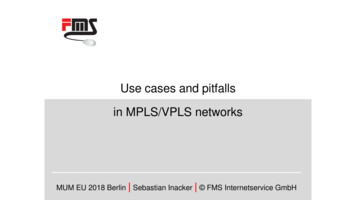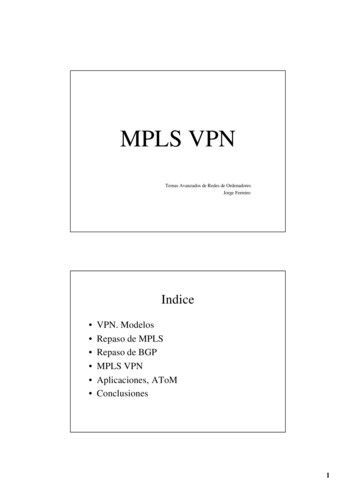
Transcription
MPLS Virtual Private NetworksLuca CittadiniGiuseppe Di BattistaMaurizio PatrignaniSummaryThis chapter is devoted to Virtual Private Networks (VPNs) designed with Multi Protocol Label Switching(MPLS) [14, 15, 1], one of the most elusive protocols of the network stack. Saying that MPLS is “elusive” isnot overemphasizing: starting from its arduous fitting within the ISO/OSI protocol stack, continuing with itsentangled relationships with several other routing and forwarding protocols (IP, OSPF, MP-BGP, just to namea few), and ending with the complex technicalities involved in its configuration, MPLS defies classificationsand challenges easy descriptions.On the other hand, and in a seemingly contradictory way, the configuration of VPNs with MPLS israther simple and elegant, despite the complexity of the underlying architecture. Also, MPLS flexibilityand maintenance ease make it a powerful tool, and account for its ubiquity in Internet Service Providers’networks.The chapter is organized as follows. Section 1 gives a brief introduction and motivation behind theconcept of Virtual Private Network and explains why Layer 3 MPLS VPNs are by far the most popularwidespread kind of VPNs deployed today.In Section 2 we introduce the reader to basic concept and terminology about Label Switching (alsoknown as Label Swapping) and Virtual Private Networks.Section 3 gives a high-level step-by-step description of an MPLS VPN. This is based on three mainingredients: an any-to-any IP connectivity inside the network, a signalling mechanism to announce customerIP prefixes, and an encapsulation mechanism, based on MPLS, to transport packets across the network.Section 4 explores in detail the complex interplay between IP and MPLS that is at the basis of MPLSVPNs.More technical details about dynamic routing and connecting to the Internet, advanced usage of routing,and preserving IP-specific per-hop behavior are provided in Section 5.Strengths and limitations of MPLS VPNs are discussed in Section 6. The same section proposes furtherreadings on the subject.The reader who is interested in getting only a high-level understanding on how MPLS VPNs work canread Sections 1, 2, and 3. An indepth view of MPLS VPNs can be gained by reading Sections 4 and 5.1Virtual Private NetworksAfter giving a brief introduction and motivation behind the concept of Virtual Private Network, this sectionexplains why Layer 3 MPLS VPNs are by far the most popular widespread kind of VPNs deployed today.L. Cittadini, G. Di Battista, M. Patrignani, “MPLS Virtual Private Networks”, in H. Haddadi, O. Bonaventure (Eds.),Recent Advances in Networking, (2013), pp. 275-304. Licensed under a CC-BY-SA Creative Commons license.
1.1The Need for Virtual Private NetworksThe concept of Virtual Private Networks (VPNs) is essential in today’s networks and will probably becomeparamount in tomorrow’s networks, yet it is sometimes considered too advanced to be covered in a networking course. This apparently contrasts with the simplicity of the concept of a VPN: in its most generic form,a VPN is a closed (“Private”) group of nodes that want to be connected in a network (“Network”) and arewilling to use virtual connections, or pseudowires (“Virtual”) instead of physical connections.Such a definition captures the essence of a VPN from the perspective of the customer. A network providerhas a slightly different abstraction about a VPN, mostly because she has a different interpretation of thekeyword “Network”: within the graph that represents her own network, she needs to provide connectivity toa subset of the nodes. Despite being seemingly very easy, each of the other two keywords that appear in thedefinition hides a fair amount of complexity that is not obvious at first glance.Virtual Where in the ISO/OSI stack does virtualisation happen?Private Is there any authentication mechanism? Does the VPN need to preserve confidentiality of themessages?Each of these questions has many possible answers, which is the reason why there are so many differenttypes of VPNs in today’s networks. For example, a peer-to-peer network can be seen as a VPN where pseudowires are transport sessions, there is no authentication amongst nodes and no traffic encryption, and thetopology of the network is defined by a dynamic algorithm. At the opposite side of the spectrum we haveoptical networks, which can be seen as VPNs where pseudowires are light paths through optical switching devices, there is no authentication and no encryption, and the network topology is defined by simplyconfiguring arbitrary pseudowires among the nodes.In the context of VPNs, the term “virtualisation” indicates the technology that is used to multiplex trafficfrom multiple VPNs on the same underlying network topology. The most important feature of a VPNtechnology is what multiplexing technique is used and at which layer of the protocol stack. In general,pushing the multiplexing component down to the lower layers of the protocol stack (e.g., the physical ordata-link layer) implies a higher implementation cost compared to the higher layers (e.g., the transportor application layer). For example, deploying an optical network to be able to run arbitrary pseudowiresbetween two computers is several orders of magnitude more expensive than connecting those two computersto the Internet and writing a software that establishes a tunnel between them. On the other hand, multiplexingis transparent to upper layer protocols: for this reason, multiplexing at lower layers in the stack allows us tosupport a wider fraction of the protocol stack.The most common layers where multiplexing happens are layer 2 and layer 3. A layer 2 VPN (L2VPN)transports packets of a specific layer 2 protocol and hence, thanks to the layered architecture of the protocolstack, is capable of supporting any kind of layer 3 protocol. L2VPN technologies join the nodes belongingto the same VPN within the same broadcast domain. For example, with a L2VPN, all nodes in the VPNcould participate in the same VLAN and exchange Ethernet packets. We refer the reader to [3] for a detaileddiscussion of requirements for L2VPNs, and to [2] for a reference model of L2VPNs and a discussion of themain functional components. Analogously, a layer 3 VPN (L3VPN) transports packets of a specific layer3 protocol and hence is capable of supporting any kind of layer 4 protocol. Nodes belonging to the sameL3VPN can exchange IP packets that are routed through a provider network. We refer the reader to [8]for a detailed discussion of requirements for L3VPNs, and to [7] for a reference model of L3VPNs and adiscussion of the main functional components.
1.2Layer 3 VPNs and MPLSLayer 3 VPNs are by far the most popular of VPNs deployed today. One reason is that layer 3 offers agood trade-off between deployment cost and transparency to end hosts. Another, perhaps stronger reasonis that, as the Internet converged towards today’s everything-over-IP scheme, it seemed natural to place themultiplexing component at the highest layer that supports transporting IP packets1 .Despite a variety of technologies to realize virtual layer 3 services, most L3VPNs are based on the MultiProtocol Label Switching protocol (MPLS). The popularity of an L3VPN technology strongly depends onits ability to meet the demands of customers, providers, and vendors:Customers’ needs: Typical VPN customers (e.g., private companies, public administrations, etc.) haveseveral geographically distributed sites and would like to have a unique IP network connecting all ofthem. Besides mere connectivity, they have other requirements: (i) they want to keep their own IPaddressing plan for all the sites; (ii) they want their traffic to be logically separated from the trafficof other customers that happen to use the same shared infrastructure; and (iii) they want guaranteedquality of service.Providers’ targets: Providers have invested lots of resources in building their own network backbone.Since they have an existing infrastructure with many distributed PoPs (Points of Presence) connectedto the backbone, they would prefer to sell pseudowires rather than physical connections to their customers. Among multiple techniques to implement pseudowires, providers prefer those that involvelower configuration efforts, which usually implies lower maintenance costs. Moreover, they want theimplementation to be scalable with respect to the number of customers: the amount of state to keep inthe core of the network should only depend on the network topology, not on the number of customerVPNs.Vendors’ strategies: No network technology can be easily deployed without meeting the strategies of network device producers and vendors, whose immediate aim is to sell many machines (possibly expensive carrier-grade routers) and, in the long run, to drive the shift from a variety of old technologies forVPNs (e.g., ATM or Frame Relay) to new technologies that are simpler to manage and hence have thepotential to grow the vendor’s market share.After having introduced MPLS terminology and having given an overview of its main building blocks,in Section 6 we discuss the extent to which MPLS is able to meet the above requirements.Throughout this chapter we will refer to a very simple scenario (see Fig. 1) where a provider has a networkinfrastructure with three PoPs (in Turin, Milan, and Rome) and offers connectivity to two customers. Customer 1 has two sites and has an IP addressing plan that allocates the 200.1.6.0/24 to its site in Milan andthe 10.0.0.0/24 to its site in Rome. Customer 2 has two sites too and has an IP addressing plan that allocatesthe 10.0.0.0/24 to its site in Turin and the 193.1.1.0/24 to its site in Rome. Observe that the two customershave overlapping IP address space.We will use the sample scenario to illustrate most of the concepts introduced in this chapter. The textthat describes and refers to the sample scenario will be framed into shaded boxes like the one that enclosesthis paragraph. The configuration language is that of a leading router vendor and references can be foundin [9].1 We are recently observing a similar convergence trend at layer 2 with Ethernet: consequently, in the last few years there has beena significant increase in the demand of virtual layer 2 services.
Figure 1: The sample network used throughout this chapter.2Background and TerminologyIn this section we introduce the reader to basic concept and terminology about Label Switching (also knownas Label Swapping) and Virtual Private Networks.Throughout the chapter, we extensively refer to two tightly related yet distinct concepts: forwardingand routing. Forwarding is the process of receiving a packet from a network interface and deciding onwhich interface that packet should be sent. Usually, in order to minimize the latency of traversing a router,the decision about where to forward a packet is taken based on some pre-computed data structure. This isusually referred to as the forwarding table because a table is the simplest logical structure to accommodateforwarding information. A table can be used as a physical data structure if addresses can be matched exactly.However, IP addresses must be forwarded based on the longest matching prefix [10]. This implies thatefficient IP lookups need a more sophisticated data structure than a table. We refer the reader to [18] for adiscussion on various data structures and algorithms to speed up prefix-match lookups, which exceeds thescope of this chapter. In the following, we simply refer to the logical forwarding table, irrespective of theactual physical data structure.Routing is the process by which each router builds its forwarding table and adapts it as the networktopology changes over time.Correspondingly, we have forwarding and routing protocols, where the formers describe the formattingrules for network packets and the conventions that routers and hosts have to follow in order to exchangethem, while the latter describe packet formats and conventions used to exchange routing information amongrouters. The information that routing protocols provide is used by each router to populate its forwardingtable.Finally, standard network terminology distinguishes between the corresponding router’s software layers.Namely, the layer where the forwarding process takes place is called data plane or forwarding plane, whilethe layer where the routing process is managed is called control plane.
Destination /24Egress interfaceen2en1en2Table 1: Structure of the forwarding table in the “forwarding by network address” approach.Figure 2: A label switching network (where labels are not swapped at each hop).2.1Label SwitchingIn this section we introduce the concept of label switching as a forwarding paradigm. After having describedthe fundamentals characteristics of label switching in general, we move to MPLS-specific details in thefollowing sections. Traditionally, there are two different approaches to packet forwarding, each mappingto a specific structure of the forwarding table. They are called forwarding by network address and labelswitching.The most intuitive approach is forwarding by network address, that is the approach of IP. When a packetarrives at a router, the router parses the destination address from the packet header and looks it up in itsforwarding table. The forwarding table has a simple 2-column structure where each row maps a destinationaddress to the egress interface that the packet should be forwarded to (see Table 1). For scalability andefficiency reasons, it is possible to aggregate several destination prefixes into a single row, provided thatthey can be numerically aggregated and that they share the same egress interface.An alternative approach is known as label switching. Essentially, while forwarding by network addressrequires that the egress interface be chosen based on the destination of the packet, label switching requiresthat such an interface be chosen based on the flow the packet belongs to, where a flow corresponds to aninstance of transmission, i.e., a set of packets, from a source to a destination and is identified by a tag (calledlabel) attached to each packet of the flow.As an example, Fig. 2 shows a label switching network where each flow has an associated label (labelsIncoming interfaceen2Incoming label101Egress interfaceen5Egress label218Table 2: Structure of the forwarding table in the “forwarding by label swapping” approach with per-interfacelabel scope.
Figure 3: A label switching network (where labels are swapped at each hop).Incoming label101Egress interfaceen5Egress label218Table 3: Structure of the forwarding table in the “forwarding by label swapping” approach with per-routerlabel scope.are represented with colors). Packets with a red label belong to the flow from router A to router B of Fig. 2.If a packet with a red label enters interface 1 of router E, it will exit from interface 2 with the same label.If the label switching technologies followed the approach of Fig. 2 they would have the advantage thatlabels do not have to be changed at each hop. On the other hand, if they did they would have the bigdrawback of requiring a centralized control of the assigned labels, as labels should be unique for the entirenetwork. Fig. 3 shows what actually happens in label switching networks, where labels are swapped at eachhop. This choice requires that labels are unique for each router or for each interface only and does not needa centralized control. Fig. 4 illustrates the forwarding table of a router. Independent of whether labels areswapped at each hop or not, the forwarding paths towards the same destination node typically form a treerooted at the destination node itself, even though this is not mandatory.More formally, the operations performed by a label switching router can be summarized as follows.When the packet arrives at the router, the router extracts (pops) the label from the header, looks the labelvalue up in its forwarding table, and finds (i) the egress interface the packet should be forwarded to, and(ii) a new label to apply (push) to the packet.A forwarding process based on labels rather than destination addresses poses challenges to the corresponding routing protocols. In fact, the instances of flow traversing the network might be much morevolatile than the addressing scheme used to identify their destinations. Before transmitting a new flow, aroute from its source to its destination has to be computed and a new label has to be assigned to each leg ofthe route. As observed before, in order to facilitate the task of picking a new, unused, label, labels are notrequired to be unique for the entire network but are required to be unique for each router or for each interfaceonly. This is why they have to be changed at each hop. Depending on whether labels have a per-interfaceor per-router scope, the forwarding table is structured as in Table 2 or Table 3, respectively. Observe thatsuch a simple structure for forwarding tables allows efficient lookups (e.g., by using a hash table or a directaccess table).Label switching is not a unique feature of MPLS and it is not necessarily implemented at the networklevel of the protocol stack: other protocols, notably ATM and Frame Relay, traditionally adopt the same
Figure 4: A label switching network where the forwarding table of a router is shown.Layer 3Layer 2.5Layer 2Layer 1IPMPLSEthernet, Frame relay, ATM, PPP, etcPhysical layerFigure 5: MPLS and ISO/OSI network layers.forwarding mechanism. Initially, the reason to prefer label switching was performance: looking up a labelvalue in the forwarding table was much faster than looking up an IP address. Besides the fact that labelscan take values in a much smaller range than IP addresses, label values can be looked up exactly, while IPaddresses need to be looked up by the longest matching prefix. However, modern routers use extremelyspecialized hardware (e.g., content-addressable memories) and very efficient data structures (e.g., tries) toimplement their forwarding tables, in such a way that the performance gain of label switching over forwarding by destination address is now believed to be no longer an argument.2.2MPLS header and terminologyThe MPLS protocol brings the label switching forwarding paradigm to the extreme, managing, instead of asingle label, a whole stack of labels, where the external one determines the egress interface. It does not fit theISO/OSI model very well. The MPLS header is transported over L2 packets and can encapsulate L3 packetsas well as L2 packets. Since MPLS does not fit the definition of either L2 protocols nor L3 protocols, it isfrequently referred to as a “layer 2.5” protocol, emphasizing the fact that it requires L2 connectivity and canencapsulate IP packets.When an IP packet from a router needs to be transported over an MPLS backbone, the first MPLSenabled router in the network pushes an MPLS header in between the Ethernet header and the IP header.The resulting packet layout is depicted in Fig. 5.The MPLS header consists of a stack of 4-byte records where each record has the following structure(depicted in Fig. 6): a label field (20 bits), which carries the label value;
20 bitsLabel31ToS S8 bitsTTLFigure 6: Structure of a record in an MPLS header.Figure 7: The evolution of the MPLS label stack as a packet traverses several routers that perfom randompush and pop operations. a ToS field (3 bits) which is used to discriminate different levels of quality of service (QoS) and tocarry explicit congestion notifications (ECN); a bottom-of-stack field (1 bit) which is set to 1 when the record is the last record in the stack; and a TTL field (8 bits) which is decremented at each hop, similarly to the TTL field in the IP header.When an MPLS-enabled router receives a packet, it can perform three different operations: (i) push alabel onto a (possibly empty) stack, (ii) pop a label from the stack (possibly resulting in an empty stack),or (iii) swap the top label of the stack, which can be seen as a pop operation followed by a push operation.Figure 7 shows the evolution of the MPLS label stack as a packet traverses several routers that performrandom push and pop operations.MPLS-VPN terminology uses specific names to distinguish routers that do not understand labels at all,routers that push (or pop) labels, and routers that simply swap labels. Routers belonging to the first group arecalled customer edge (CE) routers because they are not MPLS-enabled. Typically those are the customer’srouters that need to be interconnected via an L3VPN. CE routers can only handle IP packets and are notaware of the MPLS layer which is used to implement the VPN.Routers belonging to the second group are called provider edge (PE) routers, or label edge routers(LERs). They are placed at the edge of the MPLS backbone of the provider, have direct connectivity to theCE routers, and act as the access point for the customer to the VPN. While they need to perform label swapoperations because they are part of the backbone, they spend most of their time pushing labels (when an IPpacket comes from a CE router) and popping labels (when an MPLS packet needs to be forwarded to a CErouter).Routers belonging to the third group are called provider (P) routers, or label switching routers (LSRs).They are in the core of the MPLS network. Since they do not interact directly with non-MPLS routers, they
Figure 8: Inside the provider’s infrastructure.mainly perform label swapping operations in order to forward packets to other P or PE routers.MPLS groups destinations into Forwarding Equivalence Classes (FEC). Packets that need to be forwarded to the same CE using the same path and with the same quality of service belong to the same FEC.Fig. 8 shows some details of the provider’s infrastructure of our scenario. It is both an MPLS network andan IP network (it has an MPLS data plane and an IP data plane).If we look at it from the MPLS point of view, we can distinguish CE, PE, and P routers. The small,red routers placed at the customer premise in the corners of Fig. 8 are CE routers. CE routers are directlyattached to the blue routers at the edge of the provider premise, which are the PE routers (or LERs). Finally,the grey routers in the core of the provider network are the P routers (or LSRs).Since the provider network is also an IP network an IP address is given to the interfaces. To do this, ourprovider exploits prefix 80.0.0.0/8. This prefix will not be announced outside the provider’s network. Thereason for the presence of label AS100 in the provider network will be explained soon.The two CE routers serving Customer 1 are connected through a VPN called VPN1 (on the right sideof Fig. 8). The two CE routers serving Customer 2 are connected through a VPN called VPN2 (on the leftside).3Checkmate VPNs in Three MovesIn this section we give a high-level description of an MPLS VPN. Such a description is based on three mainingredients that we call “moves”. We claim that a reader that understands these three moves will be able tocheckmate this complex matter.From the perspective of the customer, an MPLS VPN simply routes IP packets among customers CErouters, as if they were connected by a pseudowire. Observe that, as customers may have overlapping
address spaces, their packets cannot be simply routed through the provider network. Instead, they need to beencapsulated. It is tempting to implement such a pseudowire using a tunnel (e.g., GRE, IP-in-IP or IPSec)between PE routers where the customer packets travel across the provider network encapsulated into IPor IPSec packets. However, as the number of interconnected sites grows, manually managing configuredtunnels and maintaining forwarding tables becomes excessively complex. For example, if we were to usetunnels to implement an L3VPN over 5 customer sites, a full-mesh topology would translate to 20 manuallyconfigured tunnels. Moreover, if the customer adds a new subnet to one of its sites, we need to update theforwarding tables of all our 5 PE routers. Observe that the complexity of managing tunnels can be eased byautomatic setup mechanisms. However, such mechanisms are out of the scope of this chapter, therefore werefer the interested reader to [16, 13, 17].The intrinsic problem with tunnels is that they rely on a pre-determined endpoint which is configured attunnel setup time. Ideally, we would like to take advantage of the benefits of encapsulation without dealingwith the issue of knowing the tunnel endpoint in advance. Namely, we would like packets to be encapsulatedat the ingress PE and decapsulated at egress PE. We can split this goal into three high-level steps that we callmoves:Move 1: Achieve any-to-any IP connectivity among PEs,Move 2: Define a signalling mechanism to distribute customer prefixes among PEs, andMove 3: Define an encapsulation mechanism to transport packets from one PE to another across the network.One of the key benefits of using encapsulation (Move 3) is that the complexity of configuring L3VPNsfor customers is confined to PEs. The core of the network (i.e., P routers) does not need to know anythingabout customer prefixes: it simply needs to know how to transport packets from one PE to another (Move1). This means that the size of the forwarding table of P routers depends on the number of PE routers ratherthan on the number of customer prefixes. Finally, if PE routers use a signalling mechanism to dynamicallysynchronize the list of customer prefixes, the only pieces of information that need to be manually configuredat each PE are the L3VPN identifier and the IP address of the CE router.In the following we elaborate each move in more detail.3.1Move 1 – Any-to-any IP connectivity among PEsThe first move is actually quite simple. It is nothing more than what any Internal Gateway Protocol (IGP) isdesigned to achieve: seamless, redundant and dynamic IP-level any-to-any connectivity. Since PEs are ourencapsulation endpoints, we want them to be reachable independent of the availability of specific networkinterfaces. In other words, we do not want to use the IP address of physical interfaces for PEs, but loopbackaddresses. A loopback address is an address associated with a virtual interface of the router. Since it isvirtual, a loopback interface it is active independent of the status of physical network interfaces. To fulfillMove 1, we simply assign a loopback address to each PE router and use an IGP (e.g. OSPF or IS-IS) toannounce these addresses as /32 prefixes in order to ensure any-to-any connectivity among them.Fig. 9 shows the loopback addresses assigned to the PEs of our example network. Also, we assume thatrouters use OSPF to propagate reachability information of loopbacks of routers.Configuring routers to fulfill Move 1 is straightforward. In our sample network, the configuration ofLER1 for Move 1 is as follows.
Figure 9: Loopbacks of PEs.Figure 10: IP connectivity for LER1.
Figure 11: IP connectivity for LSR2.Figure 12: The OSPF weight of a link.
interface Loopback0ip address 80.80.80.1 255.255.255.255interface GigabitEthernet1/0ip address 80.1.1.1 255.255.255.252router ospf 10network 80.0.0.0 0.255.255.255 area 0The first two lines assign an IP address to interface loopback0. The second pair of lines assign an IPaddress to interface GigabitEthernet1/0 that connects LER1 with LSR1. The last two lines activateOSPF protocol.Fig. 10 shows the result of command show ip route performed on router LER1. Fig. 11 shows theresult of command show ip route performed on router LSR2. Command show ip route has theeffect of showing the control plane routing table of routers.In order to force a more interesting routing in the following part of the example, we set OSPF weight500 for a specific link, discouraging the use of that link by the IGP routing protocol, as shown in Fig. 12.3.2Move 2 – Use BGP to distribute customer prefixesIn order to distribute reachability information about customer prefixes, MPLS relies on a variant of BGPcalled Multi-Protocol BGP (MP-BGP)[5]. Whereas BGP advertises reachability information for IPv4 addresses only, MP-BGP supports multiple address families (e.g., IPv4 and IPv6). Since advertising VPNaddresses implies exchanging not only IPv4 prefixes, but also additional information to identify the VPN,MP-BGP treats VPNs as a separate address family. PE routers establish a full-mesh of iBGP peerings andeach PE announces to all the other PEs the customer prefixes that it can reach via the CE router it is connected to. The Multi-Protocol extension to BGP is needed to introduce the concept of the “customer” (i.e.,the “L3VPN identifier”) which does not exist in plain BGP.Compared with any ad-hoc signalling mechanism that could have been designed specifically for MPLS,the choice of using BGP has the advantage of relying on a well-known protocol and thus making the learningcurve smoother for practitioners. Moreover, BGP has built-in mechanisms (e.g., route reflection) to scale asthe number of PE routers increases.Fig. 13 shows a high-level illustration of how the BGP peerings with LER3 and LER2 can be used by LER1to announce customer prefixes.Configuring MP-BGP peerings isings.Consider the followingvery similarsnippet fromtotheconfiguring plain iBGP peerconfiguration of router LER1:
Figure 13: Use of BGP to distribute customer prefixes.router bgp 100neighbor 80.80.80.4 remote-as 100neighbor 80.80.80.4 update-source Loopback0neighbor 80.80.80.5 remote-as 100neighbor 80.80.80.5 update-source Loopback0!address-family vpnv4neighbor 80.80.80.4 activateneighbor 80.80.80.5 activateexit-address-familyThe first line starts the BGP configuration and states that the router belongs to AS100. Observe that allthe routers are supposed to belong to Autonomous System (AS) 100. This AS number will not be necessarilypropagated
This chapter is devoted to Virtual Private Networks (VPNs) designed with Multi Protocol Label Switching (MPLS) [14,15,1], one of the most elusive protocols of the network stack. Saying that MPLS is "elusive" is . topology of the network is defined by a dynamic algorithm. At the opposite side of the spectrum we have
